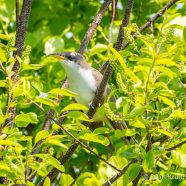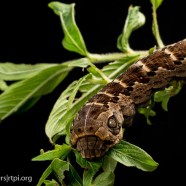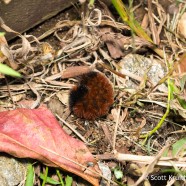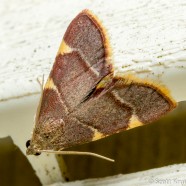Yellow-billed Cuckoo (Coccyzus americanus)
We had a very welcome late morning visitor at Stratford Point today in the form of this Yellow-billed Cuckoo (Coccyzus americanus) as it searched out tent caterpillars on the bluff. The American Robins and Common Grackles were not as welcoming, thinking this bird was going to go after their nests and little ones. The light was not the best for photography, but it is hard to get better views of a cuckoo than this! Stratford Point keeps bringing in the migrants even as we near the end of May. Scott Kruitbosch Conservation & Outreach Coordinator
Read MoreSnake Caterpillar?
While transferring photographs from my recent Panama trip onto my computer, another quick pick jumped out at me. This large caterpillar was found by Dave Huth on our first night in Cocobolo Nature Reserve and the longer I watched it, the more its resemblance to a snake blew me away. The indication of scales in just the right places, spots suggesting nostrils, even the white ‘catchlight’ in its fake eyes…and it moves in just the right ways too! I know my Central American snakes pretty well, but even a cursory glance at this caterpillar tripped all sorts of alarm bells in my...
Read MoreBanded Woolly Bear
This Banded Woolly Bear caterpillar (Pyrrharctia isabella) had already gone into defensive mode, balling up after I spotted it and before I returned with my camera. I will say one thing for this individual – I love the look! The old story goes that more extensive black covering the body means it will be a colder and snowier winter will be for us, and the more brown a caterpillar has the warmer it will be. Even though it is not stretched out you can see how much brown we have here, and I like it! I think we could all go for a warmer winter than the last two historically cold seasons. I...
Read MoreClover Hayworm Moth
Here’s what seems to be the Clover Hayworm (Hypsopygia costalis) moth, a species that I saw on multiple occasions during the middle of the summer. Apparently their name is derived from their caterpillars being a historic pest in haystacks, and they feed on various forms of dried vegetation. Scott Kruitbosch Conservation & Outreach Coordinator
Read MoreMuch Milkweed
It is becoming more and more apparent that what pollinators need are more of their plants, and without chemicals! The Monarch butterfly needs milkweed like this in fields and grasslands across America. If you have open space like this please try to do your best to keep them unmowed, unpolluted and full of milkweed plants next year. Manicured and toxic lawns are wastelands for our insects.
Read More








